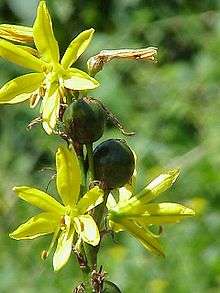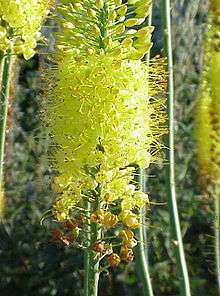Asphodeloideae
Asphodeloideae is a subfamily of the monocot family Asphodelaceae in the order Asparagales. It has previously been treated as a separate family, Asphodelaceae sensu stricto.[1] The family Asphodelaceae has now been proposed to be a nomen conservandum, and the proposal has been recommended for ratification in 2017. In that case, Asphodelaceae will have priority over Xanthorrhoeaceae. This is reflected in the APG IV family lists.[2]
| Asphodeloideae | |
|---|---|
 | |
| Yellow asphodel (Asphodeline lutea) | |
| Scientific classification | |
| Kingdom: | Plantae |
| Clade: | Tracheophytes |
| Clade: | Angiosperms |
| Clade: | Monocots |
| Order: | Asparagales |
| Family: | Asphodelaceae |
| Subfamily: | Asphodeloideae |
| Genera | |
|
See text | |
| Synonyms | |
|
Aloinaceae | |
The subfamily name is derived from the generic name of the type genus, Asphodelus. Members of group are native to Africa, central and western Europe, the Mediterranean basin, Central Asia and Australia, with one genus (Bulbinella) having some of its species in New Zealand. The greatest diversity occurs in South Africa.
The genera Aloe, Asphodelus, and Kniphofia are perhaps best known from their use in horticulture as ornamental plants.

Description
The Asphodeloideae are distinguished by a general presence of anthraquinones, simultaneous microsporogenesis, atypical ovules morphology, and the presence of an aril.[3] Asphodeloideae also have a characteristic secondary growth by means of a secondary thickening meristem.[3] This character, however, is also found in other taxa in the Asparagales, including Agavaceae, Iridaceae, and Xanthorrhoeoideae. It is confined to Asparagales among the monocots and is believed to have evolved independently in most families.[3]
Aloin cells
The presence of aloin cells is a distinctive character of the Aloeae. These cells are present in all Aloeae, but are absent in most of the other genera within Asphodeloideae.[3] A well-developed cap of thin-walled parenchyma cells occurs at the phloem pole of each vascular bundle.[4] Chase posits that they are involved in secondary metabolite production,[3] but Beaumont suggests that the cells act as a storage tissue for compounds synthesized in the surrounding layer of cells.[5] The aloin cells are said to produce the characteristic thick exudate that is produced when the succulent leaf of aloe is severed.[5] The aloin cells produce anthraquinone and chromone derivatives,[5] which may be responsible for the medicinal attributes of Aloe.
Taxonomy
Lotsy (1911) placed a number of genera (Kniphofia, Notosceptrum, Chortolirion and Aloe) into a family, separate from Asphodelaceae, the Aloinaceae.[6] Other taxonomists have subsequently circumscribed a tribe, Aloineae (or Aloeae) to include Gasteria, Haworthia and Aloe. Other taxonomic terms have included Aloaceae, Alooideae, Aloideae, Aloidea, Aloides, Aloinae and Aloeace, with the type genus Aloe.[7]
Phylogeny of Asphodeloideae
There is agreement among many researchers that Asphodeloideae can be further divided into a monophyletic group comprising Aloe and its immediate relatives, and a nonmonophyletic group of the remaining genera.[3][4][8] The monophyletic group can be treated as the tribe Aloeae within the subfamily Asphodeloideae by those adopting the broad APG IV system circumscription of the Asphodelaceae. (Alternatively, it may be treated as the subfamily Alooideae within a more narrowly circumscribed family Asphodelaceae.)[9] Aloeae are mainly rosulated-leaf succulents, while the other genera are not succulent. The genera in Aloeae are centered in southern Africa, while the other genera have mainly a Eurasian distribution.[8]
Aloeae
As of October 2017, Aloeae (or Alooideae s.s.) comprises Aloe, Aloiampelos, Aloidendron, Aristaloe, Astroloba, Gasteria, Gonialoe, Haworthia, Haworthiopsis, Kumara and Tulista.[10] The genera within Alooideae have several morphological characters that can be distinguished in the field, namely the arrangement and type of leaf and inflorescence.
Evidence for monophyly of Aloeae is based on distinctive karyotype and characteristic leaf morphology. The Bulbine group has characteristics of Aloeae, but is not included in the group due to a lack of tubular flowers. Kniphofia is considered an outgroup of Aloeae since it has tubular flowers and a fusion of perianth segments, but it lacks succulent leaves.[4]
Selected list of genera
The genera listed below are those accepted by APWeb as of December 2019.[9][11] Other treatments combine some of these genera into as few as seven.
- Aloe L.
- Aloiampelos Klopper & Gideon F.Sm.
- Aloidendron (A.Berger) Klopper & Gideon F.Sm.
- Aristaloe Boatwr. & Manning
- Astroloba Uitewaal
- Asphodeline Rchb.
- Asphodelus L.
- Bulbine Wolf
- Bulbinella Kunth
- Chortolirion A.Berger
- Eremurus M.Bieb.
- Gasteria Duval
- Gonialoe (Baker) Boatwr. & J.C.Manning
- Haworthia Duval
- Haworthiopsis G.D.Rowley
- Jodrellia Baijnath
- Kniphofia Moench
- Kumara Medik
- Trachyandra Kunth
- Tulista Raf.
For a phylogeny of the family, see the phylogenetic tree at Asphodelaceae.[12]
References
- Chase, M.W.; Reveal, J.L. & Fay, M.F. (2009), "A subfamilial classification for the expanded asparagalean families Amaryllidaceae, Asparagaceae and Xanthorrhoeaceae", Botanical Journal of the Linnean Society, 161 (2): 132–136, doi:10.1111/j.1095-8339.2009.00999.x
- Angiosperm Phylogeny Group (2016). "An update of the Angiosperm Phylogeny Group classification for the orders and families of flowering plants: APG IV". Botanical Journal of the Linnean Society. 181 (1): 1–20. doi:10.1111/boj.12385.
- Chase, M.W.; De Bruijn, A. Y.; Coz, A. V.; Reeves, C.; Rudall, P.J.; Johnson, M. A. T.; Eguiarte, L. E. (2000). "Phylogenetics of Asphodelaceae (Asparagales): An analysis of plastid rbcL and trnL-F DNA sequences". Annals of Botany. 86 (5): 935–951. doi:10.1006/anbo.2000.1262.
- Smith, G. F.; B. E. Van Wyk (1991). "Generic Relationships in the Alooideae (Asphodelaceae)". Taxon. 40 (4): 557–581. doi:10.2307/1222765. JSTOR 1222765.
- Beaumont, J.; Cutler, D.F.; Reynolds, T. (1986). "Secretory tissues in the East African shrubby aloes". Botanical Journal of the Linnean Society. 92 (4): 399–403. doi:10.1111/j.1095-8339.1986.tb01439.x.
- Lotsy 1911, p. 725.
- Hoogland & Reveal 2005.
- Treutlein, J.; G. F. Smith; B. E. van Wyl; M. Wink (2003). "Evidence for the polyphyly of Haworthia (Asphodelaceae subfamily Alooideae; Asparagales) inferred from nucleotide sequences of rbcL, matK, ITS1 and genomic fingerprinting with ISSR-PCR". Plant Biology. 5 (5): 513–521. doi:10.1055/s-2003-44793.
- Stevens, P.F., Angiosperm Phylogeny Website: Asparagales: Asphodeloideae, retrieved 14 December 2019
- Manning, John; Boatwright, James S.; Daru, Barnabas H.; Maurin, Olivier & Bank, Michelle van der (2014). "A Molecular Phylogeny and Generic Classification of Asphodelaceae Subfamily Alooideae: A Final Resolution of the Prickly Issue of Polyphyly in the Alooids?". Systematic Botany. 39 (1): 55–74. doi:10.1600/036364414X678044.
- Grace, Olwen M.; Klopper, Ronell R.; Smith, Gideon F.; et al. (2012). "A revised generic classification for Aloe (Xanthorrhoeaceae subfam. Asphodeloideae)" (PDF). Phytotaxa. 76 (1): 7–14. doi:10.11646/phytotaxa.76.1.1.
- Dion S. Devey, Ilia Leitch, Paula J. Rudall, J. Chris Pires, Yohan Pillon, and Mark W. Chase. "Systematics of Xanthorrhoeaceae sensu lato, with an emphasis on Bulbine". Aliso 22(Monocots: Comparative Biology and Evolution):345-351. ISSN 0065-6275.
Bibliography
- Lotsy, J. P. (1911). Vorträge über botanische stammesgeschichte, gehalten an der Reichsuniversität zu Leiden. Ein lehrbuch der pflanzensystematick. III (1) Cormophyta Siphonogamia (in German). Jena: G. Fischer.CS1 maint: ref=harv (link)
- Hoogland, Ruurd D.; Reveal, James L. (January 2005). "Index Nominum Familiarum Plantarum Vascularium". The Botanical Review. 71 (1): 1–291. doi:10.1663/0006-8101(2005)071[0001:INFPV]2.0.CO;2. JSTOR 4354495.CS1 maint: ref=harv (link)
- Sharma, Arun Kumar; Mallick, Ranajit (November 1965). "Interrelationships and evolution of the tribe Aloineae as reflected in its cytology". Journal of Genetics. 59 (2): 20–47. doi:10.1007/BF02984142.CS1 maint: ref=harv (link)
- Asphodeloideae At: Angiosperm Phylogeny Website At: Missouri Botanical Garden Website
- Asphodelaceae in L. Watson and M.J. Dallwitz (1992 onwards). The families of flowering plants: descriptions, illustrations, identification, information retrieval. Version: 9 March 2006. https://web.archive.org/web/20070103200438/http://delta-intkey.com/
- NCBI Taxonomy Browser
- links at CSDL, Texas
External links
| Wikimedia Commons has media related to Asphodeloideae. |
| Wikispecies has information related to Asphodeloideae |